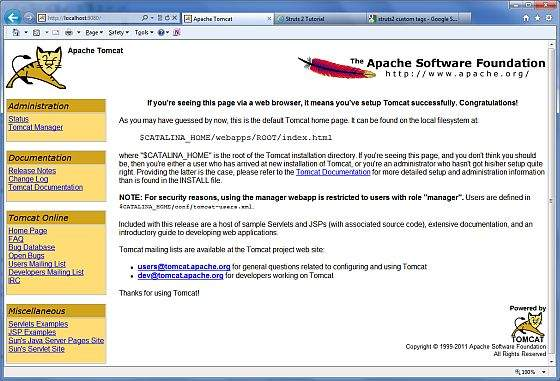Flex environment settings
May 25, 2021 Flex
Table of contents
2. Step 1 - Verify the Java installation on your computer
3. Step 2 - Install the Java Development Kit (JDK):
This tutorial will show you how to prepare your development environment to get started with Adobe Flex Framework. This tutorial will also teach you how to install JDK and Adobe Flash Builder on your machine before setting up the Flex framework:
System requirements
FLEX requires JDK 1.4 or later, so the first requirement is to install JDK on your computer.
| Jdk | 1.4 or above. |
|---|---|
| Memory | There are no minimum requirements. |
| Disk space | There are no minimum requirements. |
| Operating system | There are no minimum requirements. |
Follow the given steps to set up your environment to start Flex application development.
Step 1 - Verify the Java installation on your computer
Now open the console and execute the following java command.
| Operating system | Task | Command |
|---|---|---|
| Windows | Open the command console | c:\> java -version |
| Linux | Open the command terminal | $ java -version |
| Mac | Open the terminal | machine : ~ joseph $ java -version |
Let's verify the output of all operating systems:
| Operating system | The output is generated |
|---|---|
| Windows |
java version "1.6.0-21" Java (TM) SE Runtime Environment (build 1.6.0-21-b07) Java HotSpot (TM) Client VM (Build 17.0-b17, Hybrid Mode, Shared) |
| Linux |
java version "1.6.0-21" Java (TM) SE Runtime Environment (build 1.6.0-21-b07) Java HotSpot (TM) Client VM (Build 17.0-b17, Hybrid Mode, Shared) |
| Mac |
java version "1.6.0-21" Java (TM) SE Runtime Environment (build 1.6.0-21-b07) Java HotSpot (TM) 64-bit server VM (build 17.0-b17, hybrid mode, shared) |
Step 2 - Install the Java Development Kit (JDK):
If Java is not installed, you can install the Java Software Development Kit (SDK) from Oracle's Java site: .lt;a rel""nofollow" href""".html"" /b10> You will find instructions for installing JDK in the downloaded file, and follow the given instructions to install and configure the settings. /b11>Finally, PATH and JAVA_HOME environment variables are set to refer to directories containing java and java, usually java_install_dir /bin and java_install_dir.
Set JAVA_HOME environment variable to point to the base directory location where Java is installed on your computer. For example
| Operating system | Output |
|---|---|
| Windows | Set the JAVA_HOME variable to C: Program Files, Java, jdk1.6.0_21 |
| Linux | export JAVA_HOME = / usr / local / java-current |
| Mac | export JAVA_HOME = / Library / Java / Home |
Attach the Java compiler location to the system path.
| Operating system | Output |
|---|---|
| Windows | Attach the JAVA_HOME% to the end of the system variable Path. |
| Linux | export PATH = $ PATH:$ JAVA_HOME / bin / |
| Mac | No, you don't need to |
Step 3 - Set up Adobe Flash Builder 4.5
All the examples in this tutorial were written using the Adobe Flash Builder 4.5 Profession IDE trial. /b10> So I suggest you have the latest version of Adobe Flash Builder installed on your machine on your operating system.
To install the Adobe Flash Builder IDE, http://www.adobe.com/in/products/flash-builder.html. /b10> After downloading the installation, unziw the binary distribution package to a convenient location. /b11> For example, on Windows, C: s flash-builder, or linux / Unix on / usr / local / flash-builder, and finally set the PATH variable appropriately.
Flash Builder can be started by executing the following commands on a Windows machine, or by hitting FlashBuilder directly .exe
%C:\flash-builder\FlashBuilder.exe
Flash Builder can be started by executing the following commands on Unix (Solaris, Linux, etc.):
$/usr/local/flash-builder/FlashBuilder
The Adobe Flash Builder trial is available for 60 days. /b10> Accept only the terms and conditions, skip the initial registration step, and continue to use the IDE. /b11> We are using the trial version for teaching purposes.
After a successful startup, if everything is fine, it should show the following results:

Adobe Flash Builder is pre-configured with the FLEX SDK. /b10> We used FLEX SDK 4.5 in our examples, which are provided with Adobe Flash Builder 4.5.
Step 4: Set up Apache Tomcat:
You can download http://tomcat.apache.org/ version of Tomcat from the website . /b11> After downloading the installation, unziw the binary distribution package to a convenient location. /b12>For example, on Windows, C:\apache-tomcat-6.0.33 or Linux/Unix/usr/local/apache-tomcat-6.0.33, and set the CATALINA_HOME environment variable that points to the installation location.
Tomcat can start by executing the following commands on a Windows machine, or you can double-click .bat
%CATALINA_HOME%\bin\startup.bat or C:\apache-tomcat-6.0.33\bin\startup.bat
Tomcat can start by executing the following commands on Unix (Solaris, Linux, etc.):
$CATALINA_HOME/bin/startup.sh or /usr/local/apache-tomcat-6.0.33/bin/startup.sh
Once successfully launched, the default Web application contained in Tomcat will be obtained by accessing http:// localhost:8080 /. If everything is fine, then it should show the following results:

For more information about configuring and running Tomcat, see the documentation contained here and the Tomcat website: http://tomcat.apache.org
Tomcat can be stopped by executing the following command on a Windows machine:
%CATALINA_HOME%\bin\shutdown or C:\apache-tomcat-5.5.29\bin\shutdown
Tomcat can be stopped by executing the following commands on Unix (Solaris, Linux, etc.) machines:
$CATALINA_HOME/bin/shutdown.sh or /usr/local/apache-tomcat-5.5.29/bin/shutdown.sh